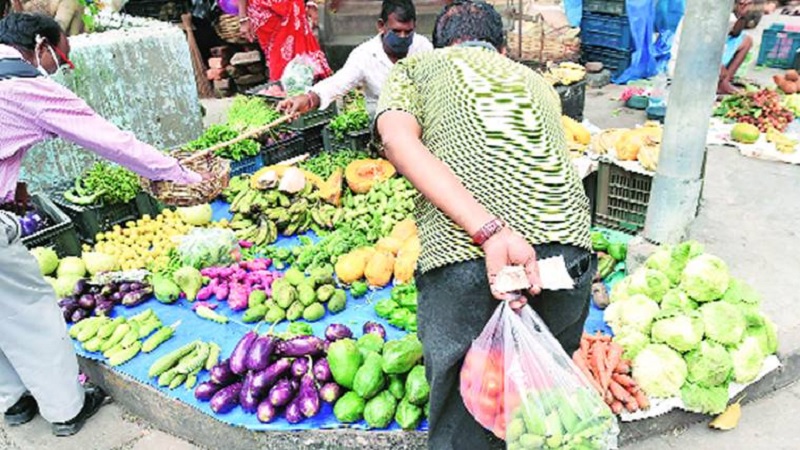 Image Courtesy:indianexpress.com
Image Courtesy:indianexpress.com
Cyclone Amphan has brought along with itself manifold problems for West Bengal and Odisha. However, West Bengal seems to have borne the maximum wrath of the disaster. On May 18, the Indian Meteorological Department had warned that Cyclone Amphan would cause extensive damage to standing crops, plantations and orchards; apart from uprooting large, bushy trees and blowing down palm and coconut trees.
CM Mamata Banerjee has pegged the loss from Amphan at Rs. 1 lakh crore after it wrecked homes and damaged crops, especially in North and South 24 Parganas which house city supply hubs like the Basirhat sub-division and Bongaon.
Vegetable prices have skyrocketed in city markets as the cyclone took a toll on the demand and supply chain. Due to roads being blocked by uprooted trees, vegetable trucks have not been able to reach markets. Due to this authorities have to buy vegetables and other commodities from other districts at high prices, making their prices shoot up.
A survey of prices in Kolkata showed that ladies’ fingers (okra) and cucumber, which were sold at Rs 30 per kg before cyclone Amphan hit the state, was now being sold at Rs 50 per kg. Similarly, carrots and brinjal were each being sold at Rs 60 per kg — Rs 20 per kg more than last week. The price of green chillies has shot up to Rs 150 per kg from Rs 70 per kg, while one kg of tomatoes was sold at Rs 50 from Rs 20 per kg. Even poultry prices have gone up. One kg chicken was being sold at Rs 260 to 270 per kg compared to Rs 220 to 230 last week, The Indian Express reported.
According to media reports, 14 out of 23 districts in West Bengal had been affected due to the cyclone. Vijay Bharti, District Magistrate, Burdwan (East) told The Statesman, “Boro paddy on 46,712 hectares was still left to be harvested and crops on 33,000 hectares got absolutely destroyed due to Amphan. Besides, sesame on 12,340 hectares and summer vegetable cultivated on 5,000 hectares also was wiped out.”
In Odisha, loss of ripened paddy in around 60 percent of the cropped areas in Balasore district has been reported. Farmers in Jagatsinghpur, Kendrapara, Mayurbhanj, Bhadrak and Puri too suffered major losses, and an area of over one lakh acres in these districts has been reported to be affected. Over 100,000 hectares of agricultural land has been damaged in Odisha said Revenue and Disaster Management Minister Sudam Marandi.
Betel leaf farmers suffer heavy losses
Betel leaf farming that has been the source of livelihood for many across West Bengal and Odisha has suffered from the natural calamity. The Telegraph reported that a large number of families residing in at least 10 blocks of South Parganas like Namkhana, Patharpratima, Kakdwip, Gosaba and Basanti depend on betel leaves. In East Midnapore, betel leaves are cultivated in Tamluk, Nandakumar, Mahishadal and Ramnagar and at least 2 lakh betel leaf farmers here and in South 24 Parganas have been affected due to the cyclone.
The projected loss that betel leaf farmers in West Bengal have suffered stands at Rs. 2,775 crore after betel leaves on 2,477 hectares of land were damaged in South 24 Parganas. In East Midnapore, the damage stands at Rs. 1,000 crore.
Mrinal Kanti Bera, assistant director of Agriculture (plant division) in Tamluk said that betel leaves have been partially or fully damaged in around 5,000 hectares.
Apart from this, the Horticulture department has reported that the cyclone has ravaged banana orchards grown in 6.5 thousand hectares in Nadia, West Bengal, affecting over 90,000 people. Mango production too has sustained heavy damage with over 38,000 tonnes of mangoes having been destroyed as per the assessment of a mango wholesaler.
Jute crops grown in 7.5 million hectares in North 24 Parganas, Hooghly, Nadia, Murshidabad, East Midnapore and Howrah – the main jute belt in the state – has also been damaged severely. Dr. Gouranga Kar, director of the ICAR-CRIJAF told The Statesman, “The cyclone severely affected the standing jute crop by lodging, specially that attains a height of 0.5 to 1.5 mt. Severe cyclonic wind with heavy rainfall almost swept the crops to the ground level. Lodging of the plant and water logging may adversely affect the further growth and fibre production if proper post-cyclone care is not taken.”
In light of Cyclone Amphan, the Centre had announced Rs. 1,000 crore and Rs. 500 crore in aid for West Bengal and Odisha respectively.
Related: